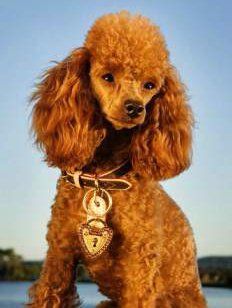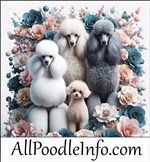Red Poodles
With so many Poodle colors, many cannot choose a favorite. However, it is the red Poodle that is so rare, so stunning and so special.
Bringing this color into the Poodle genes and being able to produce such a shocking and beautiful dog was not easy. Let's take a look at how this was done and what you should know about his particular dog.
Red poodles are rare and are of a faded gene.
When they are produced, the pups usually come from dogs with apricot lines, which can be confusing to many since of course red is a much darker and deeper color.
While the DNA of red poodles still needs to be better understood, they do appear to be of a completely separate gene, sometimes referred to as the “rufus” gene.
This gene may work to darken an apricot (or sometimes a brown) coat.
One thing that is clear is that the red gene has absolutely no affect on blacks. The apricot gene is recessive to all Poodles except for the white.
-350x263.dm.edit_5rIaV3-1920w.jpg)
Ginger, a gorgeous solid red Poodle
Photo courtesy of owner: Isabelle Desrosiers
Red only became an official AKC color
in 1980 and now many breeders in Canada have come together to form the Apricot Red Poodle Club. A true red will have black points. Liver points are acceptable but not preferred in the U.S.
It took quite a while to achieve the amazing red Poodles that we see today. It was Ilse Konig of the Shangri-La Kennel who first came up with the idea of developing a red color standard.
Experimental breeding was done by mating a small miniature apricot female Poodle to a large standard sized red at Palamares. The very first litter produced four red Poodle puppies. It is said that the color was simply amazing.

Due to the rare pairing of two different sized Poodles, this placed the dogs into a category that is between the Miniature and the Standard, called the Klein or Moyan, which is popular and recognized in Europe.
The biggest puppy from each litter was then bred…And this is what helped to slowly increase the size of the dog. After quite a few years of breeding and keeping red Poodle puppies, red Standards were then able to be bred relatively easily.
Reds can go through many color changes as the dog grows. They occasionally are born a very bright red and then lighten over time. Some will stay lighter, however in some cases the Poodle will then darken up again as he or she ages. When a red does lighten, the color will usually become a sort of cinnamon color. In most cases, they are exceptionally dark and then lighten between 1 year old and 18 months old.
Since a color change can occur during puppyhood...Or in the later adult stages, this means that the owner of an Apricot or tan my have a huge surprise if their Poodle's coat develops into this amazing, bright and rare color.
So, do be aware that a red Poodle can fade, as fading is common with this breed. The exceptional color that one may see in a young puppy will often change with time; although this is not to say that the adult coat will not be gorgeous in its own right.
When one does know that they have a red, here are the most popular names that are given:
Amber
Ambrosia
Audrey
Blaze
Bordeaux
Brandy
Burgundy
Cayenne
Cherry
Chili
Cinnamon
Claret
Copper
Crackle
Crimson

Ember
Fire
Flame
Foxy
Merlot
Rojo
Rose
Rowan
Ruby
Spark
Spice
SunKiss
Sunset
Tabasco
Terra
Valentine
